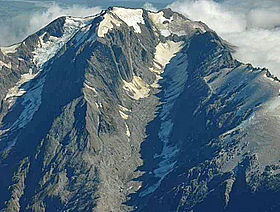- Mount Adams (New Zealand)
-
Mount Adams 
Mount Adams from the south-east, Escape Glacier at left, Seige Glacier (partially covered in rock debris) at centre. Late summer conditions.Elevation 2,208 m (7,244 ft) Prominence 754 m (2,474 ft) Location Location South Island, New Zealand Range Southern Alps Coordinates 43°16′06″S 170°31′40″E / 43.2682°S 170.5277°E Topo map Topo50 BW17 - Harihari
NZMS 260: I35 WhataroaClimbing Easiest route New Zealand Alpine Grade 1 Mount Adams is a mountain in the West Coast region of New Zealand's South Island.[1] The summit is roughly 19 km south of Harihari and reaches 2,208 metres (7,244 ft) in height.[2]
Mount Adams lies to the west of the main divide of the Southern Alps and drains into the Whataroa and Poerua catchments. Both of these rivers flow westwards to the Tasman Sea. There are two small glaciers on the south-eastern slopes that drain the summit ice cap; the Escape Glacier (about 2.1 km in length) and the Seige Glacier (about 3.6 km).
Contents
Climate
This area, like much of the West Coast region, is subject to high precipitation by world standards. There are no rainfall gauges on Mount Adams, but a gauge in Whataroa valley at the State Highway 6 bridge 10 km south-west of the summit at 60 metres above sea level, records a mean annual rainfall of 5690mm (224 inches) and daily falls of up to 320mm (12 inches).[3] It is likely that the precipitation at higher elevations on Mount Adams will be significantly greater than this, and a rain gauge in the Cropp River 42 km north-east of Mount Adams at 860 metres above sea level, records a mean annual rainfall of 10,690mm (421 inches) and daily falls of up to 695mm (27 inches).[4]
Geology
The Alpine Fault runs across the lower North-western slopes of the mountain near the edge of the coastal outwash plain,[5] and is the boundary between the Pacific and Indo-Australian tectonic plates.[6] Mount Adams itself is composed primarily of schist of Permian–Triassic (depositional) age, which is increasingly metamorphosed closer to the Alpine Fault.[7]
On 6 October 1999, a large rock landslide originating near the northern summit of Mount Adams deposited c.10-15 million cubic metres of rock in the Poerua River 1,790 metres (5,870 ft) below. This created a 120 metre (390 ft) high landslide dam, which formed a lake that extended 1.2 kilometres upstream. The dam failed six days later during heavy rain. Fears of major damage did not turn into reality when the dam was breached, though significant quantities of coarse gravel were deposited downstream and the river's path was changed in places.[8]
Access
Mount Adams is unique in that it is one of the only glaciated peaks situated on or to the west of the main divide that is accessible as a weekend trip from a west coast road end.[9] The standard route to the summit starts from a hidden layby off SH6 and heads up Dry Creek/Little Man River to a steep spur where a marked route starts. The marked route ends at the bushline and the remainder of the climb is on tussock, rock, and eventually the summit ice cap glacier.
Although this route is technically not difficult, it involves multiple river crossings, off track travel up Dry Creek/Little Man River and above the bushline, and glacial travel requiring an ice axe and crampons.[10] The overall elevation gain, from highway to summit, is approximately 2,100 metres (6,900 ft). Most parties take two days to summit and return to SH6, though it is possible in a long summer day.
References
- ^ "Place Name Detail: Mount Adams". New Zealand Geographic Placenames Database. Land Information New Zealand. http://www.linz.govt.nz/placenames/find-names/topographic-names-db/database/index.aspx?p=11656. Retrieved 2009-04-08.
- ^ Pat Barrett, 17 August 1999, "Top From the Top", Christchurch Press, pg. 36.
- ^ West Coast Regional Council, retrieved 2010-01-01
- ^ West Coast Regional Council, retrieved 2010-01-01
- ^ Department of Geology, University of Otago, retrieved 2010-01-02
- ^ Department of Geology, University of Otago, retrieved 2010-01-02
- ^ Graham T. Hancox, Mauri J. McSaveney, and Vernon R. Manville, 2005, "The October 1999 Mount Adams rock avalanche and subsequent landslide dam-break flood and effects in Poerua River, Westland, New Zealand", New Zealand Journal of Geology and Geophysics 48, pp. 683-705.
- ^ Report on the 6 October 1999 landslide and its effects
- ^ FederatedMountain Clubs of New Zealand, FMC Bulletin July 2008, Number 176, [1]
- ^ Pat Barrett, 17 August 1999, "Top From the Top", Christchurch Press, pg. 36.
Categories:- Mountains of New Zealand
- Westland District
Wikimedia Foundation. 2010.

